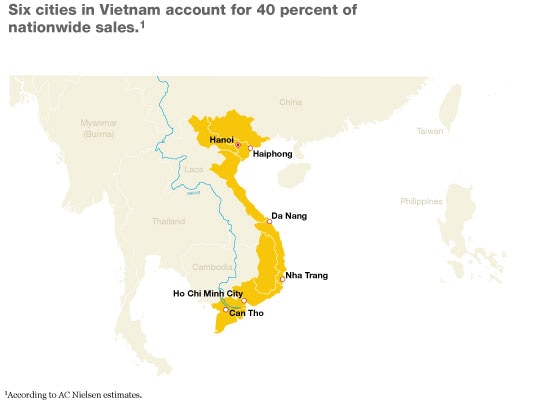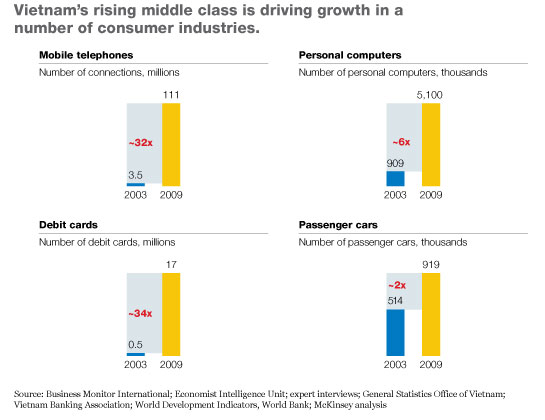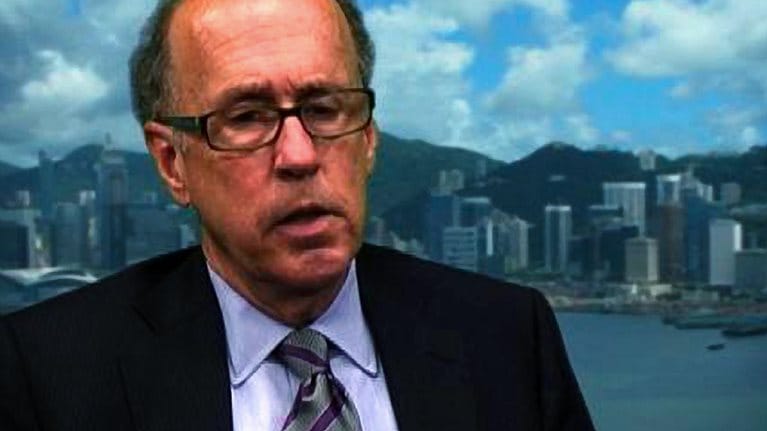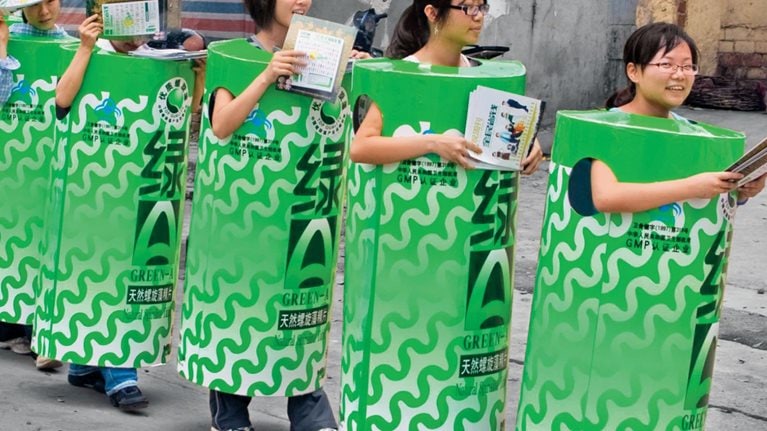Vietnam began to liberalize its economy in the 1980s, when the country’s leaders launched doi moi (or “renovation”). It was only after President Clinton lifted the US trade embargo in 1994, though, that multinationals began to pile in. Since then, Vietnam has taken off. In 2007, it joined the World Trade Organization (WTO)—just in time for the global financial crisis. The country weathered the storm well, posting 5 percent growth in 2009. This year should be even better.
For retailers and consumer goods companies, Vietnam is an attractive market: the economy is growing briskly and sustainably, and the population is adding a million people a year. Even more important, the county’s middle class, now 7 million households, is growing fast. Vietnam’s literacy rate is 92.5 percent, and from 2003 to 2008 the number of college and university students nearly doubled. The cities, though mostly small, are expanding rapidly. Six of them—Can Tho, Da Nang, Haiphong, Hanoi, Ho Chi Minh City, and Nha Trang—account for 40 percent of the country’s sales, according to AC Nielsen estimates from 2007 (Exhibit 1).

The Vietnamese government estimates that retail sales reached $39.1 billion in 2009—almost twice as high as five years earlier. And the country has room to grow: per capita retail sales, at $450, are among the lowest in Asia. Setting up shop in Vietnam, however, isn’t easy. The market is fragmented and difficult to reach, and although 100 percent foreign-owned retailers can register for an operating license, they are generally allowed to open only one outlet. To expand further, they must pass an “economic needs test,” in which the government analyzes a new project’s economic impact. The test gives local governments an effective—and sometimes arbitrary—veto over new developments. Such regulations are legal and relatively common under WTO guidelines. Even so, they are more broadly applied in Vietnam than in most other countries, limiting access to the domestic market.
McKinsey has worked in Vietnam with a number of domestic and international companies. In June 2010, we spoke with a dozen executives who do business there. We offer the following observations, based on these interviews and our own experiences, about what it takes to succeed in this dynamic market.
Know your consumers
Vietnamese consumers want the same things others do—good, reliable products that enhance their daily lives (Exhibit 2). What makes Vietnam distinctive, though, is how quickly consumers are moving up the ladder—“leapfrogging,” in the words of Unilever Vietnam’s chairman, Marijn van Tiggelen. In personal care, for example, increasing numbers of people are buying more sophisticated products. Urban Vietnamese women aged 20 to 45, for example, spend 18 percent of their monthly income on apparel, according to the General Statistics Office of Vietnam. The Vietnam Ministry of Industry and Trade forecasts that the market for beauty products will grow 15 percent a year for the foreseeable future. Jean-Yves Romagnani, the chief operating officer of TamSon, a leading luxury-goods distributor in Vietnam, with brands such as Hermès and Kenzo, told us that the market for these products, though small, is growing dramatically. (To hear more from executives discussing Vietnam’s quickly growing consumer market, see the video “Understanding the new Vietnam” or download a PDF of the transcript).

Market the message
In 2009, the General Statistics Office estimated that Vietnam had 5 million Internet subscribers and 18 million Internet users. Those figures are impressive for a country at a relatively early stage of digital development, and other estimates suggest the number is even higher. In Hanoi and Ho Chi Minh City, for instance, up to half of the population is now online, spending more than two hours a day, on average. Expenditures on digital marketing for the country as a whole, however, are still very low: only $15 million, according to Cimigo, a market research firm. As Mai Huong Hoang, the chairwoman of one of Vietnam’s leading advertising agencies, the local branch of Saatchi & Saatchi, noted, “TV is still king in Vietnam, because women are the decision makers in the family and they spend a lot of time watching TV.” However, recent McKinsey research in other emerging markets, such as China, India, and Malaysia, suggests that the pace of digital change can be rapid, especially with younger people. Therefore, businesses—particularly consumer goods companies—shouldn’t ignore digital media in their marketing plans.
Regardless of which media channels companies select, they should know that almost all Vietnamese consumers are literate—and also highly literal. Go into a grocery store and you will probably see shoppers reading the product labels. To build brands, companies had better live up to the claims they make about their products—and the more concrete the claims, the better.
See problems as possibilities
Metro Cash & Carry is a global company that sells food and other consumer goods to stores and wholesalers. Each of its nine stores in Vietnam offers tens of thousands of items, nearly all locally produced, and employs some 250 people. The company’s experience in the country shows how to build a successful business while supporting local suppliers and performing an important social function.
Food safety in Vietnam is a significant issue, with an estimated 3 million cases of food poisoning a year. People have good reason to worry about poor food hygiene and refrigeration among street vendors and wet markets. Earlier this year, the government’s food safety agency announced that 2,000 teams had inspected 47,000 businesses and found 13,000 violations during the Tet holiday alone.
Metro has made food safety a core part of its mission. The company’s focus on supply chain management and quality assurance also benefits local producers. Since 2002, Metro has trained almost 19,000 Vietnamese farmers and fisherman in food safety methods as part of its “farm to fork” quality-management system. Producers who meet these standards not only have a reliable buyer in Metro but also get access to foreign markets. Metro has done very well in Vietnam and plans to increase its operations there substantially.
Think creatively about distribution
Running about 1,000 miles from north to south, Vietnam is predominantly rural, and its infrastructure presents challenges. Only three cities (Haiphong, Hanoi, and Ho Chi Minh City) have more than one million people. Modern trade—larger self-service stores, typically belonging to chains, as opposed to wet markets or “mom and pop” shops—is growing, with more than 400 locations. Even so, this segment accounts for only about 10 percent of total retail sales (but closer to 80 to 90 percent in Ho Chi Minh City). Companies that wait for modern trade to mature could miss a chance to win consumer loyalty and market share. So how can retailers reach consumers in this dispersed and fragmented market?
Unilever has developed a network of independent and exclusive distributors that sell and distribute its goods in every nook and cranny of the country’s 63 cities and provinces. “If you want to be a successful consumer goods player in Vietnam, study Unilever,” advises Anh Tu Do, CEO of Diana, one of Vietnam’s leading consumer products companies. “We studied the way Unilever gets its products to market throughout the country, and in our company we use exactly the same model as they do.” Much of Unilever’s success comes from the degree to which it trains and monitors its distributors, giving them responsibility for managing their own operations. Of course, Unilever’s system won’t work for all businesses; the point is to approach Vietnam on its own terms.
Vietnam is one of the world’s fastest-growing economies, and there’s no reason to believe it will slow down. Its infrastructure is improving, and modern trade has made significant inroads. Asia’s youngest population and the rapid adoption of modern technology make Vietnam an exciting market. But it is by no means an easy one.


